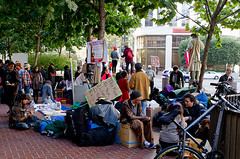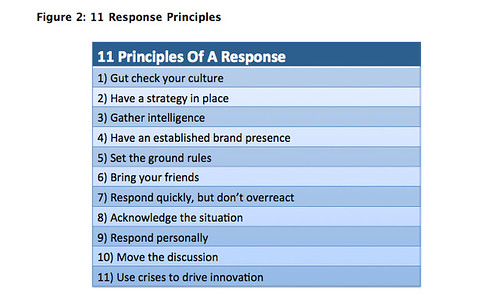 Left: Occupy SF on Sat, Oct 6th. A small group in early am manages camp in front of Federal building, crowd ebbs and flows throughout day. Photo via Ken Yeung.
Left: Occupy SF on Sat, Oct 6th. A small group in early am manages camp in front of Federal building, crowd ebbs and flows throughout day. Photo via Ken Yeung.
Three days ago on Saturday, I visited the Occupy SF location with Chris Heuer of Deloitte, Chris Saad, VP of Strategy Officer at social media startup Echo, local photographer and technologist Ken Yeung (see his photo set, which made the Huffington Post), Startup CEO Larry Chiang, Altimeter Researcher Zak Kirchner, and my business partner Charlene Li (and her son). Our mission? To interview the occupiers to understand their POV, in the context of understanding what they want, and where this movement is going to head. Every day, I run searches on Twitter and Google news to follow the story, watch videos, read blogs, and mainstream news. Yet it wasn’t enough, to really understand, and in the spirit of research, I needed to go down and see for myself and interview occupiers.
What was my goal? To understand from a first hand perspective, here’s what I found:
A small group, with a core catalyst team
The Occupy SF camp was not fully ramped when I saw it, perhaps this is what NYC looked like over a month ago. Who was there? Some would call them angry youth, homeless, old hippies, but I call them core catalysts. While they don’t look like the mainstream, you can easily see how they are able to get more involved, esp as they tap into the unions for the march last Thursday. We found some of them excessively angry, shouting demands that are unlikely to ever happen, and when I probed most, and asked “What is the solution?” they often did not know. However I did talk at length with a middle aged cab driver who was educated, and well travelled. He explained that they didn’t know the answer, but were here to point out the problem. We respectfully continued the conversation for many minutes, and shook hands while he momentarily rested his picket sign. Overall, I noticed there were many mixed messages, most were there for different reasons, including homeless folks who just learned about it and decided to join in. I even witnessed a debate between two members arguing over what should be in a picket sign as it was focused on one group’s agenda. A very mixed bag for sure.
An interesting local eco-system that starts to self-sustain
What was really interesting to see is how they were organized anarchy. The group has “general assembly” where they get together as a group and issue ideas and orders. They also have a food donation line, where supporters bring food for them to eat at any time. There was also a stationary bicycle being used to power car batteries (pic via Zak), which in turn powered cell phones, laptops. Ironically, although they were protesting in front of the Federal building, they were using wifi from some open network right in that building, here’s me in the middle of the camp. They also had a schedule of events, including workshops in which they would self-teach each other. Follow Altimeter analyst Rebecca Lieb who has been watching the Occupy Wall Street movement from Manhattan.
At a broader context, unions –and corporations– joining in
The NY model is the one to watch, as this continues to grow by the thousands, other cities may follow suit. We’ve already seen that unions (NYT reports) are joining the march and just yesterday, Unilver owned Ben & Jerry’s announced their support for the Occupy Movement and cited their stance on corporate social responsibility. I’ve been talking with Alan Webber, who has a series of steps for companies to manage disruption, which I’ve included below. We even talked to the cops (pic) who had their own opinions, (and often gave it to us) but were there to protect both the Federal property and the freedom of speech, a delicate balance.
Look back at previous stress times to predict how corporations will react
We just completed an extensive study focusing on 50 social media crises examples to understand what companies did, and what they needed to diminish the crises. While this case is far larger than any Facebook punking, we also have evaluated how GM and Ford responded online during the recall, they both created website to take the conversation head on. While both sites now redirect to their corporate website, years later, you can still find their GM Reinvention videos, repositioning as a rebirth. Altimeter analysts have been exchanging our views from our different cities and are continuing to discuss what this means for culture and business.
11 Principles For Responding To Disruption, via Alan Webber (Altimeter Analyst)

Read more on Alan’s blog on how companies should respond to disruption. I’ll be enacting the “Living room” policy for comments, I’m open to all conversations in the comments, as long as they would be the same as I would allow in my own house from guests, let’s discuss. Update: Altimeter’s Rebecca Lieb gives her perspective from NYC.
thanks for sharing
thanks for sharing